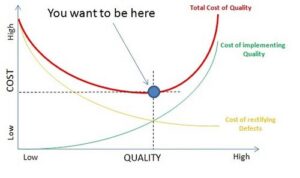Quality was defined by Juran as fit for purpose, this elegant definition applies equally to the quality of your management processes and information as it does to your production processes and project deliverables. Much is written about producing quality deliverables (products): this column looks at the cost of quality in your management work, particularly as is affects the relationships with your key stakeholders, your managers and your customers.
Fit for purpose project communications and reports provide each stakeholder with the information they need. And as with production defects the costs of failing to provide quality information can be significant; even if these costs are not easily measured. Some of the consequences include:
- A lack of confidence in your leadership leading to a lack of trust.
- Requirements to generate ever increasing numbers of reports triggering Cohn’s Law “The more time you spend in reporting on what you are doing, the less time you have to do anything. Stability is achieved when you spend all your time doing nothing but reporting on the nothing you are doing.”
- Extra layers of management, reviews and interference
- Senior management failing to heed your advice
- In extreme cases projects being cancelled for the wrong reasons.
Unfortunately the costs of poor quality in stakeholder engagement processes are frequently hidden or at least difficult to measure, whilst the cost of achieving an appropriate level of quality in your communication and stakeholder management are more obvious. However, hidden or difficult to measure does not mean insignificant, these hidden costs and consequences can destroy a project!
Successful project managers invest sufficient effort in the ‘right processes’ to achieve a good return on their investment even if measuring the costs of failure is difficult. Their objective is to minimise the total cost of quality taking into account both sides of the equation.
There are two sources of costs associated with quality:
- The first source of quality costs are the losses experienced because of poor quality, the ‘failure costs’. These include: lost revenues, lost production time caused by the lack of information or support from stakeholders, additional reporting, and the like.
- The second source of quality costs are the investments made to improve quality; the ‘prevention costs’. These include using the right tools, process improvements, employing the ‘right people’, checks and inspections; and other prevention costs.
The final cost of quality is the combination of these two parts and your objective is to lower the total cost of quality to an effective minimum. This is achieved by investing enough in the prevention costs to significantly reduce the failure costs. Crosby’s edict that ‘quality is free’ is based on this balance.
Yor ‘prevention costs’ outlined above are investments made to deliver higher quality communication. However, as with any investment, good investments yield good results, and poor investments yield poor results. The skill is investing just enough in the right places to be effective.
The secret to achieving cost effectiveness is to quickly identify and eliminate communication problems rather than committing to extensive bureaucratic processes that may cause more issues than they solve. Managed wisely, investments in prevention costs are usually minor compared to the magnitude of the potential failure costs.
Once your communications and information meet your stakeholder’s expectations a number of benefits kick in. As with any product, higher quality items have a higher perceived value; the corollary is high quality information is accepted and believed therefore you are not required to produce as much, resulting in higher stakeholder satisfaction for less effort. What could be better?
Many people are surprised to learn of the full extent of the costs of poor quality in all aspects of business. In part, this is caused by the inability of normal business reporting systems to capture all of the ‘costs of quality’ and consolidate them. This hidden nature causes a de-emphasis of a problem that deserves much more attention because of its magnitude, and the damage it can cause your project.
Now you are aware of the challenge, it’s time for you to evaluate your stakeholder reporting and engagement systems, tally your true costs of quality communication and begin to make the type of investments that can potentially yield high returns.
For a more in-depth look at this topic see: http://www.mosaicprojects.com.au/WhitePapers/WP1083_Valuing_Stakeholder_Management.pdf

